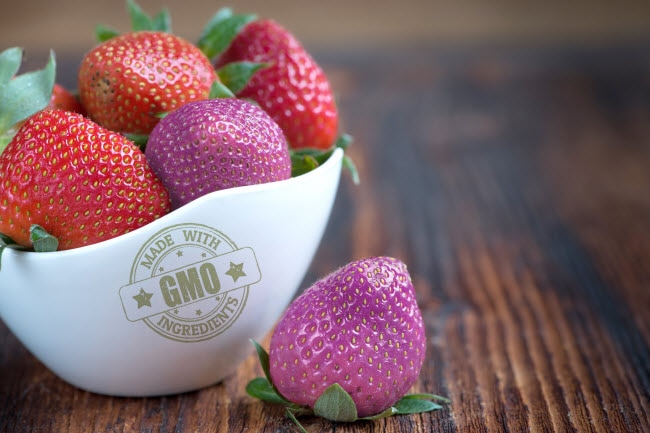“Frankenfoods” — which critics believe are the genetically modified monsters of our food chain — are simultaneously gaining and losing ground.
On the one hand, foods with genetically modified organisms (GMOs) are undergoing a wave of innovation. The Guardian newspaper recently reported that gene-editing tools like Crispr are paving the way for “a new range of fruits and vegetables that look, taste and feel very different [than] those we are used to.”
Two examples: peach-flavored strawberries and seedless tomatoes.
On the other hand, there’s increasing pushback against gene-edited foods. For instance, the European Union (EU) Court of Justice ruled in July 2018 that gene-edited crops must fall under the EU’s GMO guidelines, “dealing a potentially devastating blow to the development of enhanced crops and their underlying industry in Europe,” according to The Crispr Journal, a peer-reviewed publication that focuses on gene-editing technology.
Unlike the EU, the U.S. lacks an “established regulatory framework” for overseeing the introduction of new GMO techniques like gene editing, according to the Non-GMO Project, a major labeler of natural non-GMO products.
Are GMO fruits and vegetables safe?
Amid the gene-editing tug of war, you might be wondering: Should I be worried? What’s going to happen to the apples and oranges I buy at the grocery store?
While many scientists and medical professionals insist GMO foods are safe, foes continue to maintain a healthy skepticism — and fret about what the future holds.
“Of course, we can’t necessarily predict how any future genetic modifications might affect our food chain, but we can look at [genetically modified] foods thus far and decide on that basis,” says Dr. Lauren Deville, a naturopathic physician who’s the author of “The Holistic Gut Prescription” and “How to Be Healthy: Body, Mind, and Spirit.”
Deville points out that some research suggests genetically modified (GM) foods tend to increase the incidence of irritable bowel syndrome and leaky gut syndrome. Meanwhile, a research paper published in 2014 in the Journal of Organic Systems draws “very strong and highly significant correlations” among gene-edited crops, herbicides and “the increase in a multitude of diseases.”
Laz Versalles, director of development at Accesa Labs, a provider of medical lab testing, is firmly in the anti-gene-editing camp.
“We are so deep into the fold with genetically modified foods that its frightening. I’m personally dubious that a deeper dive in the name of new flavors and textures will benefit mankind,” Versalles says. “The consumer might find the upfront cost to be more affordable, the producers might benefit from higher yields, but what about the long-term costs of healthcare when an entire generation has been raised on fake food?”
Versalles also questions how GMOs will affect our planet.
“We’re not seeing the forest for the trees,” Versalles says. “When we see patients go to a strict whole-food diet, we see people get healthier in a matter of weeks. That should tell us something. Real food matters.”
Caleb Backe, a health and wellness expert at Maple Holistics, a retailer of natural and organic beauty products, sees the gene-editing discussion from a different perspective.
“Messing with nature has always come at a price — always with advantages and disadvantages,” Backe says. “I feel the key is to leave the option open … . My issue with the proponents of genetically modified foods is that some are talking about replacing nature, rather than providing an alternative to go alongside nature.”
Backe is concerned about the prospect of, at some point, only genetically altered foods being available to us. Still, he emphasizes there are benefits to GM foods, such as:
- Broadening the number of places where certain foods can be grown, thus helping wipe out hunger.
- Enabling foods to be colored differently, thus making some healthy foods more appealing to picky kids.
- Introducing more fruits and vegetables into our diets.
- Decreasing the need for harmful pesticides. Some GM crops have been engineered to ward off pests.
Backe acknowledges there’s been no long-term tests of GM foods, but he says short-term tests have yielded “encouraging results.”
“GM foods seem to be healthier — or rather, not as unhealthy — than thought before. The impact on the environment is not as crucial as once suspected, and it can benefit humanity in a lot of ways,” he says. “Now, to be clear, there are three sides to every story: yours, mine and the truth. This is a truth which we may never fully know.”
Backe says that while he’s never been a big fan of GM crops, they do show some promise.
“As long as GM food corporations don’t muscle out regular farming and stifle it, I say it can very well lead to good things,” he says. “But it needs to controlled and monitored properly by third-party institutions, that’s for sure.”
What do consumers think about GMO food?
In the meantime, uneasy consumers are driving up sales of non-GMO foods. By one estimate, sales of non-GMO products in the U.S. were poised to reach $264 billion in 2017. Meanwhile, the Non-GMO Project says it’s verified more than 50,000 items as non-GMO.
According to this year’s Hartman Organic and Natural Report, 46 percent of U.S. shoppers deliberately avoid GMO products, the Non-GMO Project reported in a blog post. On top of that, 36 percent of shoppers indicate they’re buying more non-GMO products than they did in 2017.
In line with the Harman report, an ABCNews.com poll conducted earlier this year found that 52 percent of American adults believe GM foods are not safe to eat, and 93 percent support federally mandated labeling of GM or “bioengineered” foods.
Many consumers “have an inherent mistrust of what is being done to their food,” the Non-GMO Project says, “and are concerned about the potential ramifications for their health and for our environment.”

